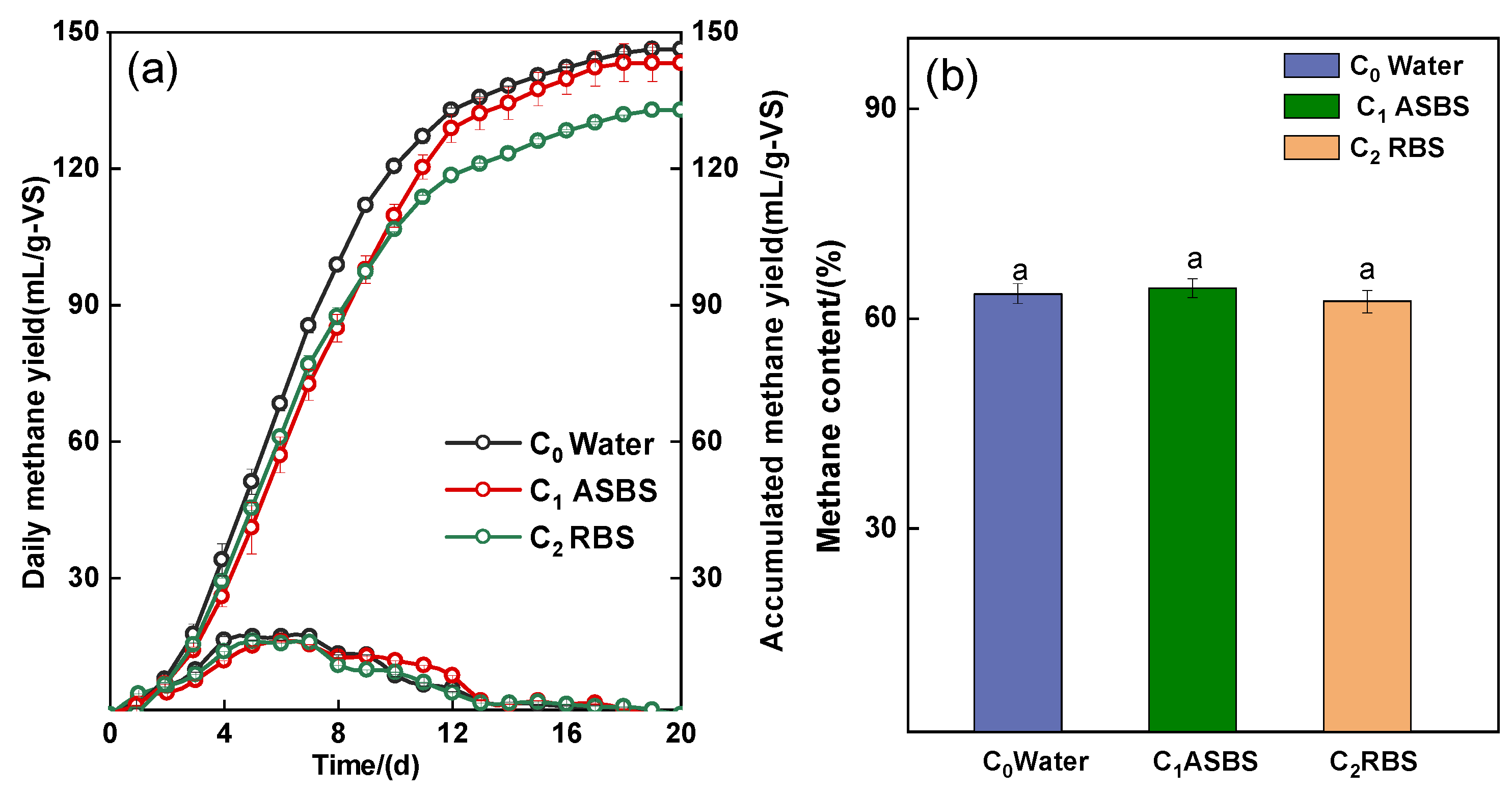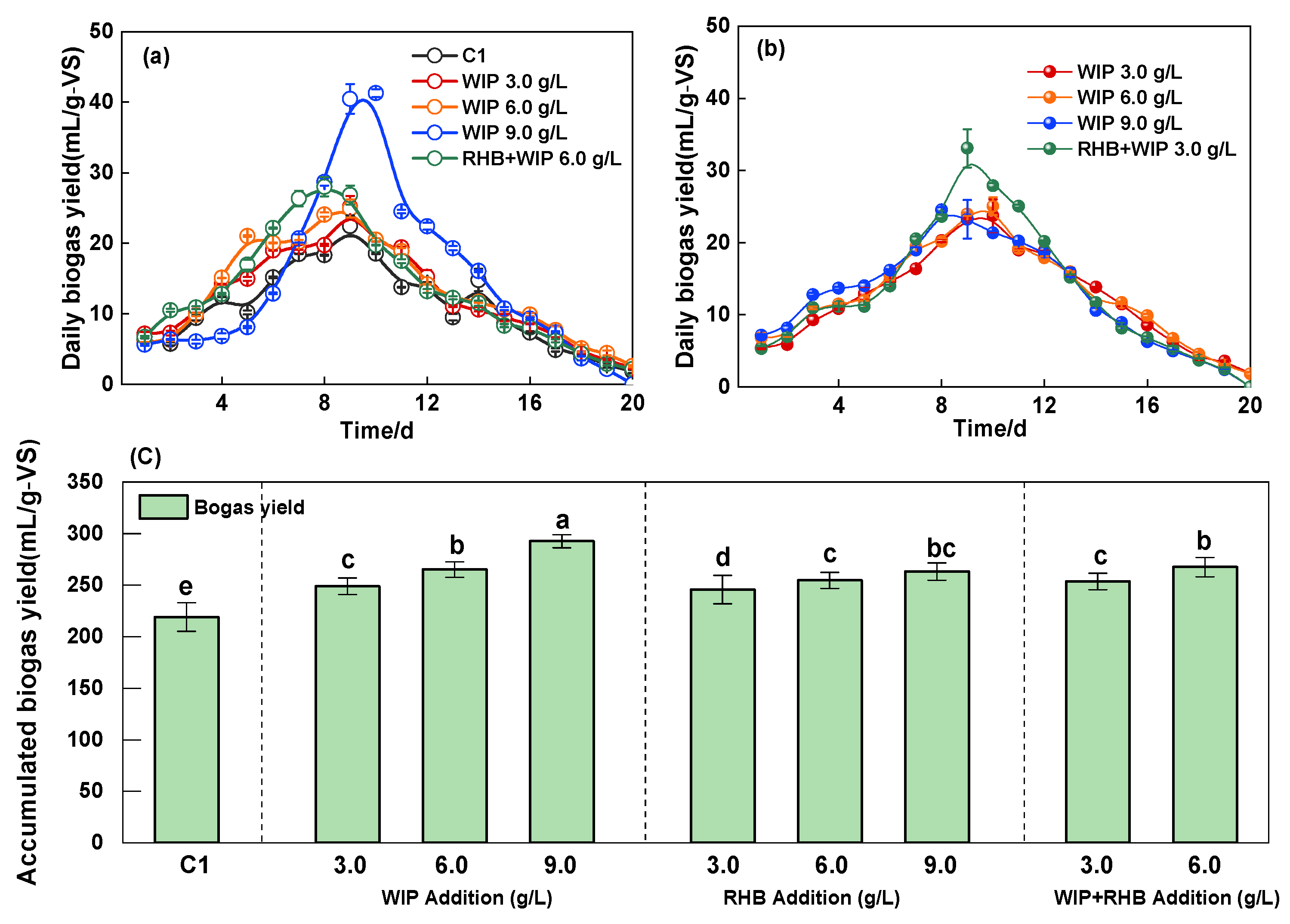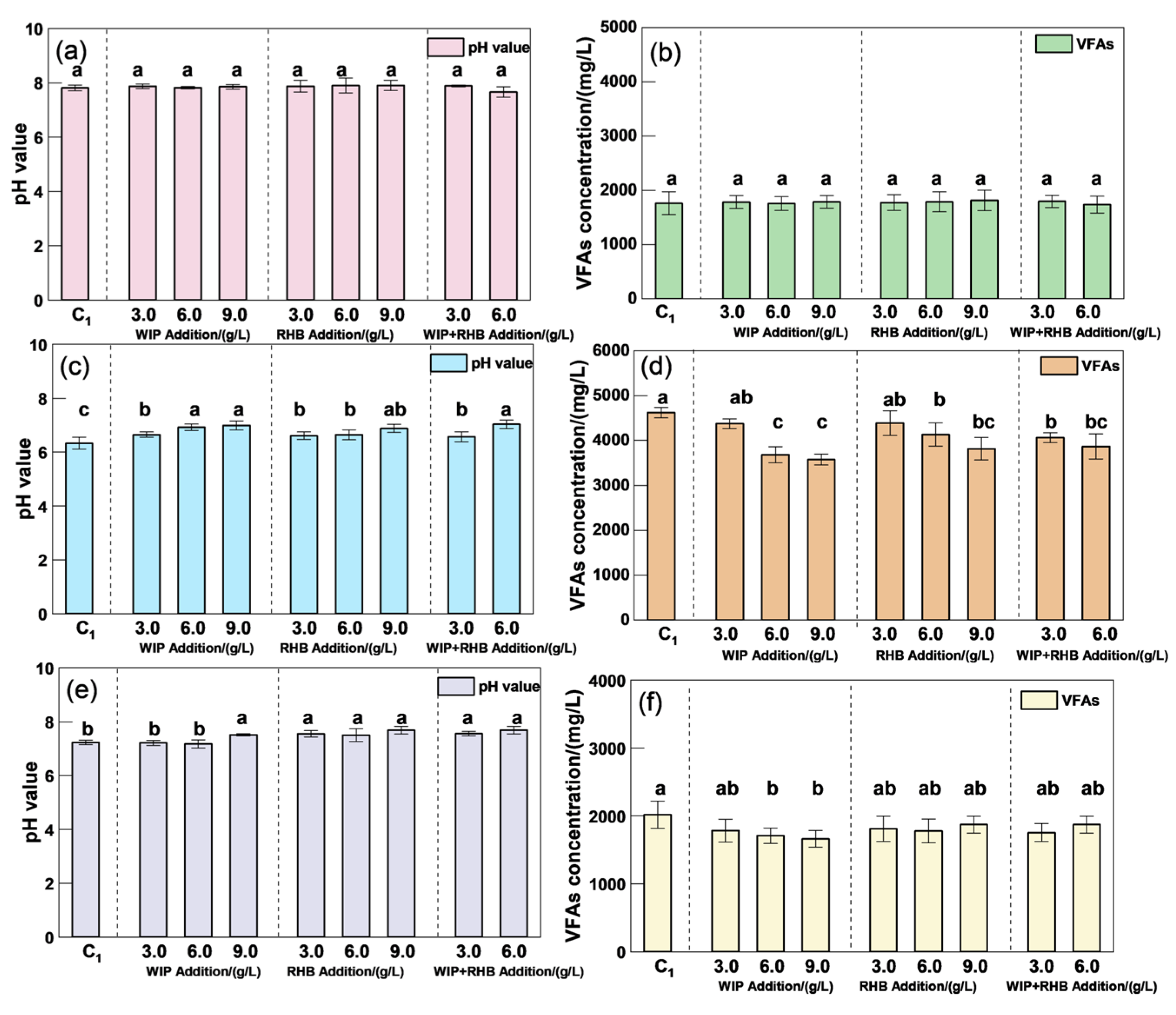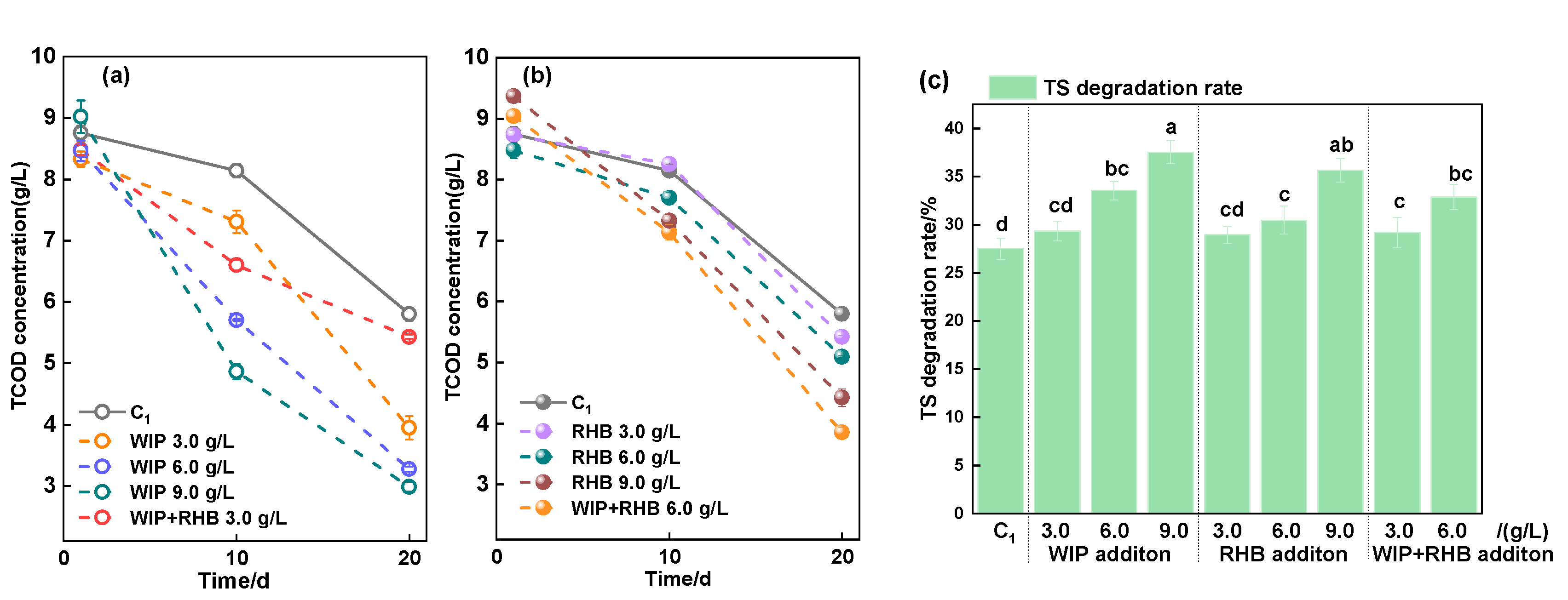Enhancing Thermophilic High-Solid Anaerobic Digestion of Swine Manure Using Ammonia-Stripped Biogas Slurry Reflux Amended with Waste Iron Powder and Biochar
Abstract
1. Introduction
2. Materials and Methods
2.1. Experimental Material
2.2. Experimental Set-Up and Operation
2.3. Analytical Methods
2.4. Data Analysis and Calculations
3. Results
3.1. AD Performance with Different Biogas Slurry Reflux
3.2. Biogas Performance for ASBS Reflux with RHB and WIP Addition
3.3. Physicochemical Properties of AD for ASBS Reflux with RHB and WIP Addition
3.3.1. VFA Concentration and pH Value
3.3.2. TAN Concentration
3.3.3. TCOD Concentration and TS Degradation Rate
3.4. Surface Changes in RHB and WIP and Analysis of Functional Groups in Swine Manure
4. Conclusions
Author Contributions
Funding
Data Availability Statement
Conflicts of Interest
Abbreviations
| AD | Anaerobic digestion |
| SMPs | Specific methane productions |
| RBS | Raw biogas slurry |
| ASBS | Ammonia-stripped biogas slurry |
| WIP | Waste iron powder |
| RHB | Rice husk biochar |
| TS | Total solids |
| VS | Volatile solids |
| TAN | Total ammonia nitrogen |
| FAN | Free Ammonia |
| TCOD | Total chemical oxygen demand |
| TP | Total Phosphorus |
| VFAs | Volatile fatty acids |
| SEM | Scanning electron microscope |
| FTIR | Fourier-transform infrared spectroscopy |
References
- Simeonov, I.; Chorukova, E.; Kabaivanova, L. Two-Stage Anaerobic Digestion for Green Energy Production: A Review. Processes 2025, 13, 294. [Google Scholar] [CrossRef]
- Łukomska, A.; Witaszek, K.; Dach, J. Current State of Development of Demand-Driven Biogas Plants in Poland. Processes 2025, 13, 2369. [Google Scholar] [CrossRef]
- Elsayed, M.; Abomohra, A.E.F.; Ai, P.; Jin, K.; Fan, Q.; Zhang, Y. Acetogenesis and methanogenesis liquid digestates for pretreatment of rice straw: A holistic approach for efficient biomethane production and nutrient recycling. Energy Convers. Manag. 2019, 195, 447–456. [Google Scholar] [CrossRef]
- Chojnacka, K.; Moustakas, K. Anaerobic digestate management for carbon neutrality and fertilizer use: A review of current practices and future opportunities. Biomass Bioenergy 2024, 180, 106991. [Google Scholar] [CrossRef]
- You, Y.; Wu, B.; Yang, Y.W.; Wang, Y.W.; Liu, S.; Zhu, Q.L.; Qin, H.; Tan, F.R.; Ruan, Z.Y.; Ma, K.D.; et al. Replacing process water and nitrogen sources with biogas slurry during cellulosic ethanol production. Biotechnol. Biofuels 2017, 10, 13. [Google Scholar] [CrossRef]
- Yun, H.; Fei, S.; Yuan, H.R.; Zou, D.X.; Pang, Y.Z.; Liu, Y.P.; Zhu, B.N.; Chufo, W.A.; Jaffar, M.; Li, X.J. Influence of recirculation of liquid fraction of the digestate (LFD) on maize stover anaerobic digestion. Biosyst. Eng. 2014, 127, 189–196. [Google Scholar] [CrossRef]
- Yue, T.; Liu, T.; Chu, X.; Zheng, G.; Wang, M.; Sun, Y. Effects of biogas slurry reflux mode and reflux rate on methane production by mixed anaerobic digestion of corn straw and pig manure. J. Clean. Prod. 2023, 411, 137214. [Google Scholar] [CrossRef]
- Zeb, I.; Ma, J.; Frear, C.; Zhao, Q.; Ndegwa, P.; Yao, Y.; Kafle, G.K. Recycling separated liquid-effluent to dilute feedstock in anaerobic digestion of dairy manure. Energy 2017, 119, 1144–1151. [Google Scholar] [CrossRef]
- Estevez, M.M.; Sapci, Z.; Linjordet, R.; Schnürer, A.; Morken, J. Semi-continuous anaerobic co-digestion of cow manure and steam-exploded Salix with recirculation of liquid digestate. J. Environ. Manag. 2014, 136, 9–15. [Google Scholar] [CrossRef]
- Wu, S.; Ni, P.; Li, J.; Sun, H.; Wang, Y.; Luo, H.; Dach, J.; Dong, R. Integrated approach to sustain biogas production in anaerobic digestion of chicken manure under recycled utilization of liquid digestate: Dynamics of ammonium accumulation and mitigation control. Bioresour. Technol 2016, 205, 75–81. [Google Scholar] [CrossRef]
- Alrbai, M.; Al-Dahidi, S.; Shboul, B.; Abusorra, M.; Hayajneh, H. Techno-economic feasibility study of ammonia recovery from sewage sludge digestate in wastewater treatment plants. Clean. Environ. Syst. 2024, 15, 100235. [Google Scholar] [CrossRef]
- Huang, S.-Y.; Wu, X.-Q.; Zhao, Q.-B.; Yu, L.; Xie, J.-F.; Zheng, Y.-M.; Zhou, T.-T.; Li, J. Prediction and Optimization of Ammonia Removal in Direct Aeration Process Based on Wastewater Properties: An Integrated Experimental and Machine Learning Approach. ACS EST Eng. 2025, 5, 1760–1773. [Google Scholar] [CrossRef]
- Xiang, S.; Liu, Y.; Zhang, G.; Ruan, R.; Wang, Y.; Wu, X.; Zheng, H.; Zhang, Q.; Cao, L. New progress of ammonia recovery during ammonia nitrogen removal from various wastewaters. World J. Microbiol. Biotechnol. 2020, 36, 144. [Google Scholar] [CrossRef]
- Kar, S.; Singh, R.; Gurian, P.L.; Hendricks, A.; Kohl, P.; McKelvey, S.; Spatari, S. Life cycle assessment and techno-economic analysis of nitrogen recovery by ammonia air-stripping from wastewater treatment. Sci. Total Environ. 2023, 857, 159499. [Google Scholar] [CrossRef]
- Palakodeti, A.; Azman, S.; Rossi, B.; Dewil, R.; Appels, L. A critical review of ammonia recovery from anaerobic digestate of organic wastes via stripping. Renew. Sustain. Energy Rev. 2021, 143, 110903. [Google Scholar] [CrossRef]
- Ni, P.; Lyu, T.; Sun, H.; Dong, R.; Wu, S. Liquid digestate recycled utilization in anaerobic digestion of pig manure: Effect on methane production, system stability and heavy metal mobilization. Energy 2017, 141, 1695–1704. [Google Scholar] [CrossRef]
- Yang, Y.; Wang, J.; Zhou, Y. Enhanced Anaerobic Digestion of Swine Manure by the Addition of Zero-Valent Iron. Energy Fuels 2019, 33, 12441–12449. [Google Scholar] [CrossRef]
- Andriamanohiarisoamanana, F.J.; Shirai, T.; Yamashiro, T.; Yasui, S.; Iwasaki, M.; Ihara, I.; Nishida, T.; Tangtaweewipat, S.; Umetsu, K. Valorizing waste iron powder in biogas production: Hydrogen sulfide control and process performances. J. Environ. Manag. 2018, 208, 134–141. [Google Scholar] [CrossRef]
- Cheng, J.; Zhu, C.; Zhu, J.; Jing, X.; Kong, F.; Zhang, C. Effects of waste rusted iron shavings on enhancing anaerobic digestion of food wastes and municipal sludge. J. Clean. Prod. 2020, 242, 118195. [Google Scholar] [CrossRef]
- Kong, X.; Wei, Y.; Xu, S.; Liu, J.; Li, H.; Liu, Y.; Yu, S. Inhibiting excessive acidification using zero-valent iron in anaerobic digestion of food waste at high organic load rates. Bioresour. Technol. 2016, 211, 65–71. [Google Scholar] [CrossRef]
- Yang, Y.; Zhang, Y.; Li, Y.; Zhao, H.; Peng, H. Nitrogen removal during anaerobic digestion of wasted activated sludge under supplementing Fe (III) compounds. Chem. Eng. J. 2018, 332, 711–716. [Google Scholar] [CrossRef]
- Chen, L.; Fang, W.; Liang, J.; Nabi, M.; Cai, Y.; Wang, Q.; Zhang, P.; Zhang, G. Biochar application in anaerobic digestion: Performances, mechanisms, environmental assessment and circular economy. Resour. Conserv. Recycl. 2023, 188, 106720. [Google Scholar] [CrossRef]
- Wang, Z.; Wang, S.; Xie, S.; Jiang, Y.; Meng, J.; Wu, G.; Hu, Y.; Zhan, X. Stimulatory effects of biochar addition on dry anaerobic co-digestion of pig manure and food waste under mesophilic conditions. Environ. Sci. Pollut. Res. 2022, 29, 19212–19223. [Google Scholar] [CrossRef]
- Cavali, M.; Libardi Junior, N.; de Almeida Mohedano, R.; Belli Filho, P.; da Costa, R.H.R.; de Castilhos Junior, A.B. Biochar and hydrochar in the context of anaerobic digestion for a circular approach: An overview. Sci. Total Environ. 2022, 822, 153614. [Google Scholar] [CrossRef] [PubMed]
- Cheng, Q.; Xu, C.; Huang, W.; Jiang, M.; Yan, J.; Fan, G.; Zhang, J.; Chen, K.; Xiao, B.; Song, G. Improving anaerobic digestion of piggery wastewater by alleviating stress of ammonia using biochar derived from rice straw. Environ. Technol. Innov. 2020, 19, 100948. [Google Scholar] [CrossRef]
- Wei, W.; Guo, W.; Ngo, H.H.; Mannina, G.; Wang, D.; Chen, X.; Liu, Y.; Peng, L.; Ni, B.-J. Enhanced high-quality biomethane production from anaerobic digestion of primary sludge by corn stover biochar. Bioresour. Technol. 2020, 306, 123159. [Google Scholar] [CrossRef] [PubMed]
- Ma, H.; Hu, Y.; Kobayashi, T.; Xu, K.-Q. The role of rice husk biochar addition in anaerobic digestion for sweet sorghum under high loading condition. Biotechnol. Rep. 2020, 27, e00515. [Google Scholar] [CrossRef]
- Shi, Y.; Liu, M.; Li, J.; Yao, Y.; Tang, J.; Niu, Q. The dosage-effect of biochar on anaerobic digestion under the suppression of oily sludge: Performance variation, microbial community succession and potential detoxification mechanisms. J. Hazard. Mater. 2022, 421, 126819. [Google Scholar] [CrossRef]
- Xu, D.-M.; Fu, R.-B.; Wang, J.-X.; Shi, Y.-X.; Guo, X.-P. Chemical stabilization remediation for heavy metals in contaminated soils on the latest decade: Available stabilizing materials and associated evaluation methods–A critical review. J. Clean. Prod. 2021, 321, 128730. [Google Scholar] [CrossRef]
- Yang, S.; Wen, Q.; Chen, Z. Effect of KH2PO4-modified biochar on immobilization of Cr, Cu, Pb, Zn and as during anaerobic digestion of swine manure. Bioresour. Technol. 2021, 339, 125570. [Google Scholar] [CrossRef]
- Rice, E.W.; Baird, R.B.; Eaton, A.D.; Clesceri, L.S. Standard Methods for the Examination for Water and Wastewater; American Public Health Association (APHA), American Water Works Association (AWWA), Water Environment Federation (WEF): Washington, DC, USA, 2005. [Google Scholar]
- Wang, D.; Xi, J.; Ai, P.; Yu, L.; Zhai, H.; Yan, S.; Zhang, Y. Enhancing ethanol production from thermophilic and mesophilic solid digestate using ozone combined with aqueous ammonia pretreatment. Bioresour Technol 2016, 207, 52–58. [Google Scholar] [CrossRef]
- Kizito, S.; Jjagwe, J.; Mdondo, S.W.; Nagawa, C.B.; Bah, H.; Tumutegyereize, P. Synergetic effects of biochar addition on mesophilic and high total solids anaerobic digestion of chicken manure. J. Environ. Manag. 2022, 315, 115192. [Google Scholar] [CrossRef] [PubMed]
- Nie, H.; Jacobi, H.F.; Strach, K.; Xu, C.; Zhou, H.; Liebetrau, J. Mono-fermentation of chicken manure: Ammonia inhibition and recirculation of the digestate. Bioresour. Technol. 2015, 178, 238–246. [Google Scholar] [CrossRef] [PubMed]
- Yenigün, O.; Demirel, B. Ammonia inhibition in anaerobic digestion: A review. Process Biochem. 2013, 48, 901–911. [Google Scholar] [CrossRef]
- Yao, Y.; Yu, L.; Ghogare, R.; Dunsmoor, A.; Davaritouchaee, M.; Chen, S. Simultaneous ammonia stripping and anaerobic digestion for efficient thermophilic conversion of dairy manure at high solids concentration. Energy 2017, 141, 179–188. [Google Scholar] [CrossRef]
- Hao, X.; Wei, J.; van Loosdrecht, M.C.M.; Cao, D. Analysing the mechanisms of sludge digestion enhanced by iron. Water Res. 2017, 117, 58–67. [Google Scholar] [CrossRef]
- Ma, L.; Zhou, L.; Mbadinga, S.M.; Gu, J.-D.; Mu, B.-Z. Accelerated CO2 reduction to methane for energy by zero valent iron in oil reservoir production waters. Energy 2018, 147, 663–671. [Google Scholar] [CrossRef]
- Farghali, M.; Andriamanohiarisoamanana, F.J.; Ahmed, M.M.; Kotb, S.; Yamamoto, Y.; Iwasaki, M.; Yamashiro, T.; Umetsu, K. Prospects for biogas production and H2S control from the anaerobic digestion of cattle manure: The influence of microscale waste iron powder and iron oxide nanoparticles. Waste Manag. 2020, 101, 141–149. [Google Scholar] [CrossRef]
- Xiao, L.; Lichtfouse, E.; Kumar, P.S.; Wang, Q.; Liu, F. Biochar promotes methane production during anaerobic digestion of organic waste. Environ. Chem. Lett. 2021, 19, 3557–3564. [Google Scholar] [CrossRef]
- Meng, L.; Jin, K.; Yi, R.; Chen, M.; Peng, J.; Pan, Y. Enhancement of bioenergy recovery from agricultural wastes through recycling of cellulosic alcoholic fermentation vinasse for anaerobic co-digestion. Bioresour. Technol. 2020, 311, 123511. [Google Scholar] [CrossRef]
- Sunyoto, N.M.S.; Zhu, M.; Zhang, Z.; Zhang, D. Effect of biochar addition on hydrogen and methane production in two-phase anaerobic digestion of aqueous carbohydrates food waste. Bioresour. Technol. 2016, 219, 29–36. [Google Scholar] [CrossRef]
- Qiu, L.; Deng, Y.; Wang, F.; Davaritouchaee, M. A review on biochar-mediated anaerobic digestion with enhanced methane recovery. Renew. Sustain. Energy Rev. 2019, 115, 109373. [Google Scholar] [CrossRef]
- Luo, C.; Lü, F.; Shao, L.; He, P. Application of eco-compatible biochar in anaerobic digestion to relieve acid stress and promote the selective colonization of functional microbes. Water Res. 2015, 68, 710–718. [Google Scholar] [CrossRef] [PubMed]
- Kizito, S.; Wu, S.; Wandera, S.M.; Guo, L.; Dong, R. Evaluation of ammonium adsorption in biochar-fixed beds for treatment of anaerobically digested swine slurry: Experimental optimization and modeling. Sci. Total Environ. 2016, 563, 1095–1104. [Google Scholar] [CrossRef] [PubMed]
- Giwa, A.S.; Xu, H.; Chang, F.; Wu, J.; Li, Y.; Ali, N.; Ding, S.; Wang, K. Effect of biochar on reactor performance and methane generation during the anaerobic digestion of food waste treatment at long-run operations. J. Environ. Chem. Eng. 2019, 7, 103067. [Google Scholar] [CrossRef]
- Anjum, R.; Grohmann, E.; Krakat, N. Anaerobic digestion of nitrogen rich poultry manure: Impact of thermophilic biogas process on metal release and microbial resistances. Chemosphere 2017, 168, 1637–1647. [Google Scholar] [CrossRef]
- Guo, Y.; Xiao, F.; Yan, M.; Tang, S.; Duan, Z.; Sun, Y.; Li, Y. Effect of ammonia on anaerobic digestion: Focusing on energy flow and electron transfer. Chem. Eng. J. 2023, 471, 144638. [Google Scholar] [CrossRef]
- Zhang, Y.; Feng, Y.; Quan, X. Zero-valent iron enhanced methanogenic activity in anaerobic digestion of waste activated sludge after heat and alkali pretreatment. Waste Manag. 2015, 38, 297–302. [Google Scholar] [CrossRef]
- Gui, X.Y.; Liu, C.; Li, F.Y.; Wang, J.F. Effect of pyrolysis temperature on the composition of DOM in manure-derived biochar. Ecotoxicol. Environ. Saf. 2020, 197, 10. [Google Scholar] [CrossRef]







| Parameters | Swine Manure | Inoculum | RBS | ASBS |
|---|---|---|---|---|
| TS (%) | 28.2 ± 0.6 | 7.4 ± 0.1 | 0.7 ± 0.01 | 0.67 ± 0.01 |
| VS (%) | 22.8 ± 0.3 | 4.5 ± 0.1 | 0.13 ± 0.01 | 0.15 ± 0.01 |
| pH value | 6.7 ± 0.3 | 7.7 ± 0.3 | 8.20 ± 0.1 | 8.8 ± 0.2 |
| COD (mg/L) | 3722.4 ± 126.9 | 4005.2 ± 172.2 | ||
| TAN (mg/L) | 1103.5 ± 11.3 | 135.5 ± 9.74 | ||
| TP (mg/L) | 27.5 ± 1.4 | 30.8 ± 1.6 |
| Factors | Levels | ||||||||
|---|---|---|---|---|---|---|---|---|---|
| 1 | 2 | 3 | 4 | 5 | 6 | 7 | 8 | 9 | |
| RHB (g/L) | 0 | 3.0 | 6.0 | 9.0 | 0 | 0 | 0 | 1.5 | 3.0 |
| WIP (g/L) | 0 | 0 | 0 | 0 | 3.0 | 6.0 | 9.0 | 1.5 | 3.0 |
| Additives | Dosage/(g/L) | MBY/(Lkg−1VS−1) | T80 | MBP/(Lkg−1VS−1) | MC/% | MMB/(Lkg−1VS) |
|---|---|---|---|---|---|---|
| C1 | 0 | 219.1 ± 2.3 e | 14 | 22.4 ± 1.5 c | 64.3 ± 1.3 c | 143.3 ± 2.5 e |
| WIP | 3.0 | 248.9 ± 1.6 d | 13 | 25.2 ± 1.6 b | 67.6 ± 2.1 b | 166.8 ± 1.8 d |
| 6.0 | 265.2 ± 1.3 b | 13 | 24.9 ± 1.3 bc | 73.3 ± 1.6 a | 193.6 ± 2.1 b | |
| 9.0 | 292.6 ± 4.1 a | 13 | 44.5 ± 2.1 a | 75.2 ± 3.2 a | 219.5 ± 1.5 a | |
| RHB | 3.0 | 245.7 ± 0.8 d | 14 | 23.7 ± 2.3 bc | 67.2 ± 1.7 b | 165.1 ± 0.7 d |
| 6.0 | 254.6 ± 1.5 c | 13 | 25.1 ± 1.2 b | 69.8 ± 0.9 b | 177.7 ± 1.4 c | |
| 9.0 | 263.2 ± 4.3 b | 13 | 27.9 ± 2.7 b | 70.5 ± 1.3 ab | 184.2 ± 2.1 b | |
| WIP and RHB | 3.0 | 243.7 ± 3.2 d | 13 | 21.4 ± 2.7 c | 70.0 ± 2.6 ab | 170.6 ± 2.8 d |
| 6.0 | 257.4 ± 8.1 b | 13 | 27.0 ± 1.4 b | 73.4 ± 1.8 a | 187.9 ± 3.6 b |
Disclaimer/Publisher’s Note: The statements, opinions and data contained in all publications are solely those of the individual author(s) and contributor(s) and not of MDPI and/or the editor(s). MDPI and/or the editor(s) disclaim responsibility for any injury to people or property resulting from any ideas, methods, instructions or products referred to in the content. |
© 2025 by the authors. Licensee MDPI, Basel, Switzerland. This article is an open access article distributed under the terms and conditions of the Creative Commons Attribution (CC BY) license (https://creativecommons.org/licenses/by/4.0/).
Share and Cite
Peng, J.; Zhang, X.; Wang, X.; Liu, Z.; Ai, P. Enhancing Thermophilic High-Solid Anaerobic Digestion of Swine Manure Using Ammonia-Stripped Biogas Slurry Reflux Amended with Waste Iron Powder and Biochar. Processes 2025, 13, 3787. https://doi.org/10.3390/pr13123787
Peng J, Zhang X, Wang X, Liu Z, Ai P. Enhancing Thermophilic High-Solid Anaerobic Digestion of Swine Manure Using Ammonia-Stripped Biogas Slurry Reflux Amended with Waste Iron Powder and Biochar. Processes. 2025; 13(12):3787. https://doi.org/10.3390/pr13123787
Chicago/Turabian StylePeng, Jingjing, Xin Zhang, Xinyu Wang, Zhe Liu, and Ping Ai. 2025. "Enhancing Thermophilic High-Solid Anaerobic Digestion of Swine Manure Using Ammonia-Stripped Biogas Slurry Reflux Amended with Waste Iron Powder and Biochar" Processes 13, no. 12: 3787. https://doi.org/10.3390/pr13123787
APA StylePeng, J., Zhang, X., Wang, X., Liu, Z., & Ai, P. (2025). Enhancing Thermophilic High-Solid Anaerobic Digestion of Swine Manure Using Ammonia-Stripped Biogas Slurry Reflux Amended with Waste Iron Powder and Biochar. Processes, 13(12), 3787. https://doi.org/10.3390/pr13123787






